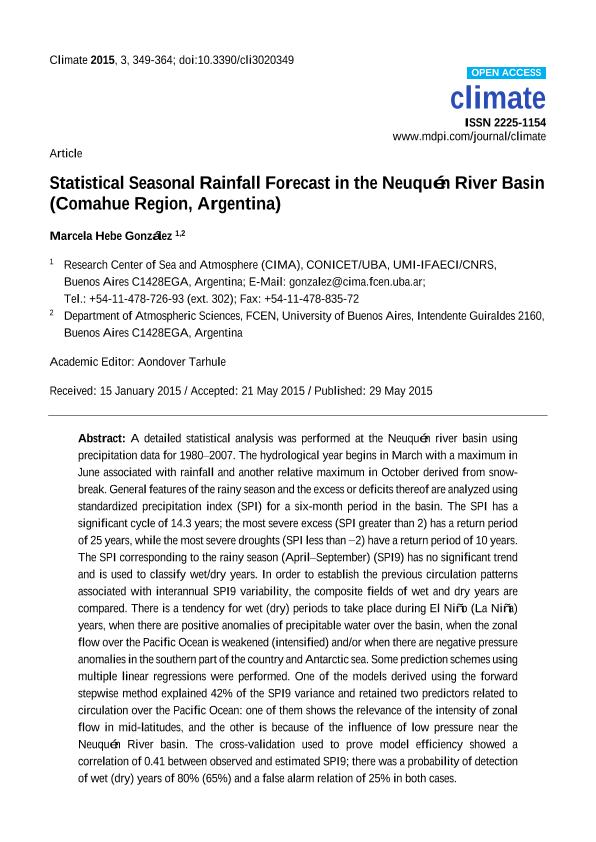Mostrar el registro sencillo del ítem
dc.contributor.author
González, Marcela Hebe

dc.date.available
2016-02-26T20:23:31Z
dc.date.issued
2015-05
dc.identifier.citation
González, Marcela Hebe; Statistical seasonal rainfall forecast in Neuquen river basin (Comahue Region, Argentina); MDPI; Climate; 3; 2; 5-2015; 349-364
dc.identifier.issn
2225-1154
dc.identifier.uri
http://hdl.handle.net/11336/4474
dc.description.abstract
A detailed statistical analysis was performed at the Neuquén river basin using precipitation data for 1980-2007. The hydrological year begins in March with a maximum in June, associated with rainfall and another relative maximum in October derived from snow-break. General features of rainy season and the excess or deficits thereof are analyzed using standardized precipitation index (SPI) for a six-month period in the basin. SPI has a significant cycle of 14.3 years; the most severe excess (SPI greater than 2) has a return period of 25 years while the most severe droughts (SPI less than -2) has return a period of 10 years. The SPI corresponding to the rainy season (April-September) (SPI9) has no significant trend and it is used to classify wet/dry years. In order to establish the previous circulation patterns associated with interannual SPI9 variability, there are compared the composite fields of wet and dry years. There is a tendency for wet (dry) periods to take place during El Niño (La Niña) years, and/or when there are positive anomalies of precipitable water over the basin and/or when the zonal flow over the Pacific Ocean is weakened (intensified) and/or when there are negative pressure anomalies in the southern part of the country and Antarctic sea. Some prediction schemes, using multiple linear regressions were performed. One of the models derived using forward stepwise method explained the 42% of the SPI9 variance and retained two predictors related to circulation over the Pacific Ocean: one of them shows the relevance of the intensity of zonal flow in mid-latitudes and the other is because of the influence of low pressure near the Neuquén River basin. The cross-validation used to prove model efficiency showed a correlation of 0.41 between observed and estimated SPI9; a probability of detection of wet (dry) years of 80% (65%) and a false alarm relation of 25% in both cases.
dc.format
application/pdf
dc.language.iso
eng
dc.publisher
MDPI
dc.rights
info:eu-repo/semantics/openAccess
dc.rights.uri
https://creativecommons.org/licenses/by/2.5/ar/
dc.subject
Precipitacion
dc.subject
Cuenca
dc.subject
Prediccion
dc.subject.classification
Meteorología y Ciencias Atmosféricas

dc.subject.classification
Ciencias de la Tierra y relacionadas con el Medio Ambiente

dc.subject.classification
CIENCIAS NATURALES Y EXACTAS

dc.title
Statistical seasonal rainfall forecast in Neuquen river basin (Comahue Region, Argentina)
dc.type
info:eu-repo/semantics/article
dc.type
info:ar-repo/semantics/artículo
dc.type
info:eu-repo/semantics/publishedVersion
dc.date.updated
2016-03-30 10:35:44.97925-03
dc.journal.volume
3
dc.journal.number
2
dc.journal.pagination
349-364
dc.journal.pais
Suiza

dc.journal.ciudad
Basilea
dc.description.fil
Fil: González, Marcela Hebe. Consejo Nacional de Investigaciones Científicas y Técnicas. Oficina de Coordinacion Administrativa Ciudad Universitaria. Centro de Investigaciones del Mar y la Atmósfera; Argentina. Universidad de Buenos Aires. Facultad de Ciencias Exactas y Naturales. Departamento de Ciencias de la Atmósfera y los Océanos; Argentina
dc.journal.title
Climate
dc.relation.alternativeid
info:eu-repo/semantics/altIdentifier/url/http://www.mdpi.com/2225-1154/3/2/349/htm
dc.relation.alternativeid
info:eu-repo/semantics/altIdentifier/doi/http://dx.doi.org/10.3390/cli3020349
dc.relation.alternativeid
info:eu-repo/semantics/altIdentifier/issn/2225-1154
Archivos asociados
